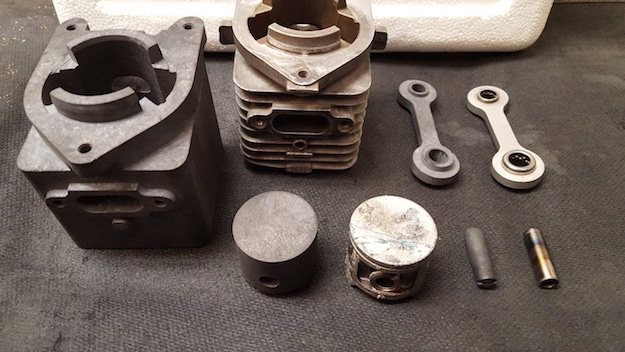September 12, 2016

Each year there are approximately 117 wind turbine fires, a major cause of wind farm failure, according to several reports from 2014. One of the major causes, outside of lightning, is overheated bearings and gearboxes. According to an article in Engineering Design Insider (EDI), “wind turbines often catch fire and burn much more frequently than is reported.”
The publication cites a study from the UK and Sweden, and researchers at Imperial College London, Edinburgh University and SP Technical Research Institute of Sweden, who report that “while an average of 11.7 turbine fires are reported annually, more than 117 fires actually occur worldwide. At present, there are an estimated 200,000 turbines in operation around the world.”
The report notes that a wind turbine fire can be more significant than other types of energy fires such as gas or oil, and gives the example of an Australian wind farm containing 112 turbines. “When one of them caught fire during a heat wave, the entire farm was shut down, cutting power to 63,000 homes,” said the report. “In addition, burning debris from the turbine ignited ground fires that destroyed 80,000 hectares of a national park. The cause of the fire was found to be electrical failure in the nacelle. Lightning strikes are the most common cause of wind turbine fires.”
Randy Lewis just might have a way to prevent some of those fires. “Lightning I can’t fix, but from what I can find out, the primary fixable problem causing fires is overheated bearings,” Lewis told PlasticsToday. Lewis has his own consulting firm, P.R. Lewis Consulting (Charlotte, NC), and is a 50% owner in ZeMC2 (Salisbury, NC), a specialty material bulk molding compound (BMC) company that develops new materials for pump and down-hole applications, engine bearings and more.
The lubrication used in the bearings in the wind turbine nacelles is flammable, and often the lubricant overheats from friction, which can cause a fire. The BMC the company has developed may be a solution. “The BMC we use to manufacture the little two-stroke, air cooled engine we have running here in our shop is lubeless, and takes high temperatures. The engine block, piston and connections are manufactured from our BMC,” Lewis said. “I would like to propose this to the wind turbine industry as a solution, but I can’t even get a phone call returned. In my opinion and based on our tests, this stuff would solve the problem.”
|
Metal propeller shaft bearings (right) and their BMC counterparts are pictured side by side). |
A video shows an oversized plug being forced into an undersized hole. “It generates dust and heat while it is going in. When it seats, the temperature drops back below the initial starting temperature,” explains Lewis. “No friction heat at all. We are running dry in small applications relative to wind turbines, but I see no reason why it won’t scale up. Ours has no lubricant and it is also one-third the weight of steel with a glass transition temperature of 246ᴼ C. In 100% of our applications we have removed friction heat from the equation.”
An article in the August 2015 issue of Wind Power Monthly notes that the three things needed to start a fire are fuel, ignition and oxygen. “You can find all three of them in ample quantities within the nacelle of a wind turbine,” said the article. “A 1.5-mW machine, on the small side by today’s standards, can still contain up to 900 liters of lubricating and cooling oil. The nacelle itself, probably made with flammable fibre-reinforced plastic, will house acoustic insulation materials, which are also flammable. Ignition can be provided by faulty electrical and electronic components and connections, or overheating mechanical parts [especially during periods of high winds]. And high winds, the reason the turbine is there in the first place, can be guaranteed to feed the spark and fan the flames.”
These turbine fires are expensive. Wind Power Monthly estimates that a 2-mW turbine costs nearly $3 million and generates an estimated income of approximately $665,000. The article noted that offshore turbines are larger and more complex, and more difficult to repair or replace, which will increase costs in the event of a fire.
Lewis told PlasticsToday that his team currently has BMC bearings running in boat propeller shafts, with no cooling water or lubricant, at between 85o and 115o F at all revolutions per minute and torque. “All of the other materials, and I do mean all, use cooling water and run 190o to 215o F. The windmill has no cooling water and the bearings are full of flammable lubricants,” Lewis stated. “There is also hydraulic fluid in abundance.
“Offhand, the thermoset materials are used in many areas. Expoxy with woven glass sheet is used for the blades, motor components, circuit breakers and relays because of its ability to withstand high temperatures and loads, where thermoplastics would soften and fail.”
The article in EDI confirms the materials. “The nacelle is typically the main ‘fuel load’ within a turbine. Constructed of polymers, and containing insulation and a variety of cables and oils, nacelles are highly flammable. A single 1.5-mW wind turbine nacelle can contain up to 900 liters of lubricating oil including cooling and cleaning fluids,” said the article, quoting the same report as Wind Power Monthly. “The transformer, located at the base of the tower, can easily contain an additional 2,200 liters of transformer oil. Electrical/electronic equipment failure or malfunction is a common cause of fire in turbines, often caused by overheating surfaces such as bearings, gearboxes and mechanical brakes, [which] can pose a high fire risk in wind turbines.”
Lewis believes he has an excellent solution for the wind turbine industry and is currently continuing with his testing on these BMC bearings.
About the Author(s)
You May Also Like





